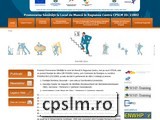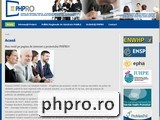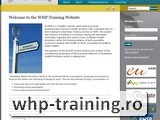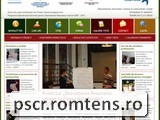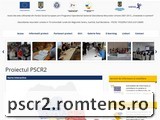About the Project
ERASMUS+ is the main EU program aiming to fund actions within the domains of education, training, youth and sport. With a total budget of 14.7 billion euros over a period of seven years (2014-2020), Erasmus+ aims to contribute to the Europe 2020 strategy for growth, jobs, social equity and inclusion, as well as the aims of ET2020, the EU's strategic framework for education and training. Erasmus+ also aims to promote the sustainable development of its partners in the field of higher education, and contribute to achieving the objectives of the EU Youth Strategy. More information on ERASMUS+ are available here.
The AGROSH+ project was submitted for evaluation to the National Agency for Community Programs in the Field of Education and Training (www.anpcdefp.ro) –under the ERASMUS+ / Key Action 2 (AC2) - Cooperation for innovation and the exchange of good practices / Strategic Partnership.
The project was submitted by ROMTENS Foundation along with its partners:
- PROLEPSIS - Institute of Preventive Medicine Environmental and Occupational Health from Greece, Athens http://www.prolepsis.gr ;
- FCBZR - Foundation "Center for Safety and Health at Work“ from Bulgaria, Sofia http://fcbzr.org ;
- UMFVBT - Victor Babeş University of Medicine and Pharmacy Timisoara from Romania, Timisoara http://www.umft.ro ;
- WRC - Work Research Centre Ireland Ltd from Ireland, Dublin http://www.wrc-research.ie ;
The project proposal project was accepted (with significant adjustments) and financed under the contract 2016-1-RO01-KA202-024790 with a total budget of 193.512,5 €. The lifespan of this project is 24 months, namely from the 1st of September 2016 to the 31st of August2018.
The selection of partners / countries was not a random one, it was informed, and determined to a certain extent, by the fact that from an economic perspective in all 4 project partner countries agriculture is a key sector. Moreover before submitting this project, Romtens Foundation performed a thorough analysis at country level in 5 countries (Romania, Bulgaria, Greece, Ireland and Spain).. According to the 2012 data of EUROSTAT/ESAW for EU-28, agriculture occupies the 4th place (out of 22 NACE categories analyzed) in terms of number of both non-fatal and fatal accidents. On the other hand, the same statistics for occupational diseases are showing a similar situation, agriculture occupies the 4th position within the economic sectors producing sick leaves in EU-28 countries (EUROSTAT/ESAW). Having taken into account these figures one of the first conclusions drawn was that there is a stringent need of specific knowledge articulated as training packages for those OSH experts and occupational medicine physicians providing services to the agriculture sector. In order to fulfill this need, AGROSH+ aims to join multiple countries in an effort to gather, adapt and adjust the specific knowledge of each partners as to enhance the competences of the relevant experts.
The general objective of the project is to enhance the knowledge and expertise of those OSH experts (safety engineers and occupational medicine doctors) who are in charge with providing OSH services (occupational safety & occupational health) to enterprises working within the agriculture sector (multiple sub-sectors comprised).
The specific objectives of the project are:
I. To assess the Training Needs of specialists (safety experts & occupational physicians) providing OSH services & Occupational medicine services to the agriculture sector;
2. To enhance the level of expertise (increasing their knowledge, skills, and attitude) for a number of 57 specialists (27 OSH experts & 30 Occ. Medical physicians);
3. To increase the level of information for a community of 100 OSH experts & Occupational medicine physicians,but also other interested parties active in the agriculture sector;
4. To enhance partners' institutional capacity (in terms of training in the fields of OSH & Occupational Medicine) so as to further impact VET and education systems in accommodating changes of their curricula and contents related to the envisaged fields.
It is aiming to achieve this results through: a training needs assessment, transnational collaborative working on 2 occupational standards, capacity building for project partners, and by strengthening ties at local level between OSH providers, OSH training providers, companies, social partners, and local public administrations. These activities, foreseen by the project, are grouped as showed below:
- Activities involving generating new materials: There will be developed two new training courses, each benefitting of the appropriate accreditation; the course dedicated to occupational medicine physicians will be accredited as a Continuous Medical Education course (thus providing CME credits) both at national and European levels, while the course for OSH experts will get accreditation from the National Authority for Qualifications. Each one of these two new training courses will have a Curriculum, as well as a Training Plan, and of course Training Materials (amongst which there will be a manual, academic presentations, a glossary, case studies, collective exercises, individual exercises, etc.).
-
Learning / Teaching / Training activities: The project proposes an innovative approach for these activities and hence foresees a tiered process (2 steps involved) for each of the two training courses:
- In the first step each partner will attend the two Joint Staff Training events (C1-"1st Joint Staff Training-Testing Course 1" (Bulgaria) and C2-"2nd Joint Staff Training-Testing Course 2" (Greece)). These events have been designed for joint work and collaborative testing of the training materials. The overall project partners' participation in the testing events is a reflection of one of the most important elements of the project design, joint authorship and joint responsibility for the two new products, namely Course 1 and Course 2 (Course 1 is the one designed for Safety Experts while Course 2 is for Occupational Medicine Physicians).
-
In the second step of this process partners will implement both of the training courses (Course 1 and Course 2), courses for which the training materials were tested in step 1. A group of three partners will implement Course 1 (Romtens Foundation, WRC Ireland, and FCBZR Bulgaria) and a group of three partners (Romtens Foundation, UMFVBT Romania and PROLEPSIS Greece) will implement Course 2.
Each of the two training courses is a blended training course, with both face-to-face and e-learning activities performed by the trainees.
- DEOR activities: (Dissemination & Exploitation of project Results): under the generic name of DEOR activities various types of activities shall be unfolded information and promotion activities, dissemination activities, etc. Examples of such activities to be performed (without being limited to) are the following: presentations within partners’ organizations, partners’ websites and newsletters, national and international conferences, social media and other means of disseminating. In addition, the project will promote the achieved results during the multiplier events (to be organized in every country). Each project partner (except for the second Romanian partner UMFVBT) will organize an event in order to disseminate at national level the intellectual outputs produced during the project within the interested relevant professional communities (OSH, occupational medicine, agriculture, public health, etc.).
- Project management and Evaluation activities: ROMTENS Foundation will perform these activities by developing and using throughout the project’s lifetime several instruments such as: procedures, templates for project implementation and reporting, but also for evaluating the project. Cooperation and communication among the partners will be facilitated by the transnational meetings, which will take place in each of the 4 countries. These meetings will also have a technical role for discussing the content for the materials developed.
During the project’s lifetime there will be produced a series of results which could be divided (solely from a descriptive perspective) into 2 (two) categories. The first category includes the tangible results such as training curricula, accreditation dossiers, training materials and evaluation packages for Course 1 and Course 2, e-learning platform and a guideline for OSH practice within the Agriculture sector. The second category includes intangible results such as (without being limited to): increased competences of the trainees (furthermore illustrated distinctively by their increased knowledge, changed attitudes, and new skills acquired), increased capacity in terms of quality and appropriateness of OSH services provided to agricultural companies, and increased capacity of the project partners in implementing training courses in these domains (OSH and occupational medicine).
More information about how and where you can access the project tangible results and more detailed descriptions of all results is available within the Project Results section of this website.
This projects aims to have more than 10000 participants who will be getting in contact with the project activities or results. These participants are encompassing the following categories:
- Project partners’ staff and experts in OSH and Occupational Medicine;
- OSH Experts who are going to be trainees attending the "Implementation of Course 1-OSH for Agriculture" event
- Occupational Medicine doctors who are going to be trainees attending the "Implementation of Course 2-Occupational Medicine for Agriculture" event
- Members of the OSH and Occupational Medicine Communities attending the Multiplier Events;
- OSH experts who are members of ENETOSH;
- Occ. Med. Doctors members of EASOM;
- Members of the ENWHP;
- Participants at national and international conferences;
- Recipients of partners’ Newsletters;
- Project Website and Project Partners’ websites visitors;
